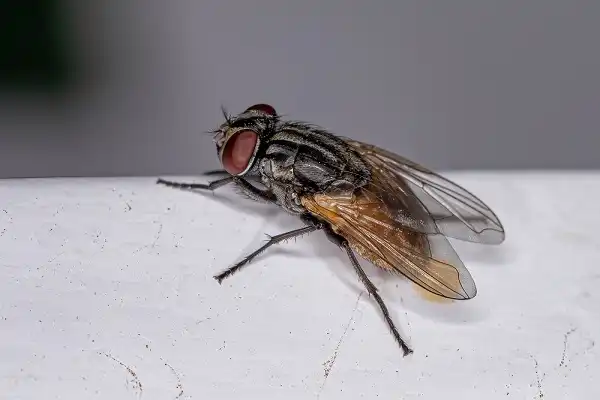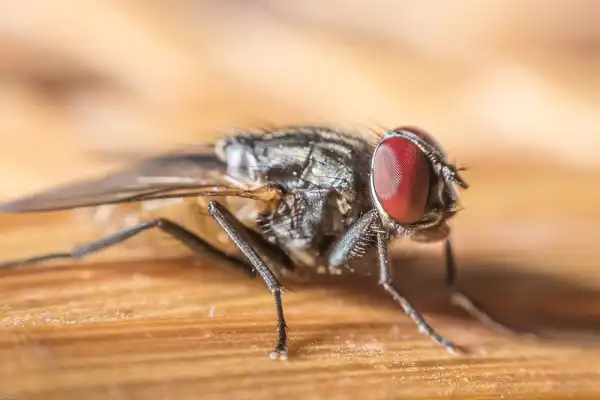The housefly is one of the most commonly found insects in homes. While they may not be the most popular household guest, it’s important to remember that they serve a purpose in nature. In this blog post, we’ll explore the life cycle of a housefly and what role they play in our ecosystem. Despite their small size, these creatures have a big impact on our world!

Housefly Description
The housefly is small. They are easily recognized by their dark body and the four stripes on their thorax. Houseflies are found all over the world and are most common in areas with warm climates. These insects are attracted to food and garbage, which is why they’re often found in homes.
Housefly Habitat
Housefly habitat is typically found in dark, moist areas such as rotting food, garbage piles, and animal feces. These insects prefer warm temperatures but can survive in colder climates if necessary. Houseflies are often found near water sources like ponds, rivers, and other waterways. They are attracted to light and will enter homes through open windows or doors. They also have the ability to transmit bacteria from one area to another by walking over contaminated surfaces. This makes them a potential carrier for various diseases, including those caused by bacteria like Salmonella. Due to their short life span and wide range of habitats, houseflies can quickly become pests in households or commercial establishments if left unchecked for too long; this is why it’s important to keep these areas clean and free from dampness where possible in order to reduce fly populations significantly.
Housefly Diet
The diet of houseflies consists mainly of decaying organic matter such as fruits, vegetables, and animal corpses. To feed, houseflies use their proboscis to pierce the surface of the food item and suck out the liquids inside. Houseflies can also feed on various types of human food, including sugary items like candies, cakes, and even spilled beverages. Moreover, they are capable of consuming foods such as milk, cheese, and other dairy products with ease. These insects might even be attracted to cooked dishes or open cans containing meats or fish. In addition to decaying organic matter and human food items, houseflies may sometimes consume dust particles in order to satisfy their nutritional needs. When these dust particles contain sugar or starch molecules, the flies will gather around them in order to extract all their nutritive values from them.

Housefly Size
Houseflies are small, winged insects that measure about 3 to 4 millimeters in length. They have a light brown color with four dark stripes running in parallel down the back of their body. The wings of houseflies are transparent and are covered in tiny hairs known as microtrichia which enable them to fly. Their antennae are short and curved, while their eyes are composed of thousands of individual lenses which allow them to detect movement very easily. Houseflies have a single pair of legs and an elongated proboscis (mouthparts) used for feeding. The size of houseflies can vary depending on their age and sex, with adult females being slightly larger than males. The youngest hatchlings will only measure a few millimeters in length while fully grown adults may reach up to 5 or 6 millimeters in length. As they age, their bodies become darker in color due to the accumulation of dirt and other contaminants on their body surface.
Housefly Lifespan
Houseflies typically have a lifespan of between 15 and 25 days. On average, they live longer in warmer climates with plenty of food sources available, while cooler temperatures and scarce food supplies may shorten their life expectancy. The adult female housefly is usually the longest-lived; she can lay up to 500 eggs during her lifetime. During the first 10 days of life, larvae will feed and grow until they reach their full size.
Once they are mature, the larvae will find a safe spot to spin a cocoon, where they will remain in a state of hibernation before emerging as an adult fly several weeks later. Once hatched, male houseflies tend to live shorter lives than female houseflies due to competition for mates. Males also expend lots of energy in flight as they search for females, which can take its toll on their health over time. Houseflies also face many dangers throughout their life cycle; predation from birds or other insects can reduce the average lifespan drastically. Parasites such as nematodes or protozoa can infect the larvae and prevent them from reaching adulthood.
Housefly Behavior
Housefly behavior is unique among insect species due to the extremely short lifespan of the adult fly. As a result, houseflies are motivated to complete their main objective within the time they have available; this goal typically involves locating food sources and mates as quickly as possible. During their search for food, houseflies rely heavily on their sense of smell which they use to detect odors from a distance up to 10 meters away. They are capable of responding to both attractive and repellent odors and can hone in on specific sources such as decaying fruits or animals by flying in a zigzag pattern while sniffing the air with their elongated proboscis (mouthparts).
In addition to searching for food or potential mates, houseflies also require shelter from predators and extreme weather conditions such as high temperatures or heavy rainfall. To accomplish this, they often seek out darker areas such as under leaves or inside cracks in walls; these areas provide safety from sudden changes in temperature or water saturation levels which could prove fatal if exposed directly. Houseflies can also engage in social behaviors such as dancing when nearby other flies; this is believed to be part of their mating ritual where males will perform intricate movements in order to attract female attention. This behavior is especially evident during the flight when several males may gather around a single female while performing elaborate maneuvers in an effort to demonstrate their strength and stamina.

Housefly Speed
Housefly speed is an impressive feat considering their short life cycle and small size. An adult housefly can reach speeds of up to 5 mph, which is the equivalent of running a mile in 10 minutes. This extreme speed allows them to quickly search for food sources or potential mates and escape predators before they are noticed. The wings of the housefly beat up to 300 times per second, enabling it to cover distances three times faster than a human can run. On average, a housefly can travel up to 250 feet in 4 seconds, making it one of the fastest insect species on the planet. In addition to their impressive top speeds, houseflies also possess exceptional agility and maneuverability. At full speed, they can change direction quickly using their pair of halteres (small balancing organs located near their wings). These small structures allow them to modify their flight path with incredible accuracy; enabling them to dodge obstacles or predators with ease.
Housefly Hunting
Housefly hunting is a skill that can come in handy, especially during the summer months when these insects are most active. Houseflies are attracted to food sources, such as waste and sweet liquids, which makes them easy targets for hunters. While some people may use traditional methods of fly swatters or bug zappers to catch houseflies, others have developed more creative ways of doing so. One popular method is “housefly hunting” with a vacuum cleaner. This technique involves slowly moving the vacuum cleaner nozzle around areas where houseflies tend to congregate and then quickly sucking them up once they’re within range. This method takes a bit of practice but can be quite effective if done correctly; it requires patience and an eye for detail since houseflies move around erratically and rarely stay still for long periods of time.

Conclusion
Catching houseflies can be a tricky business, but with the right tools and methods, it can be done. Fly swatters, vacuums, sticky traps, flypaper strips, and homemade traps are all viable options depending on your preference. Whichever way you go about hunting these pesky little critters, make sure to take proper precautions when disposing of them as some can carry diseases that could harm humans. With the right steps in place and a bit of patience, you should have no trouble getting rid of those pesky houseflies! Good luck!
Frequently Asked Question

